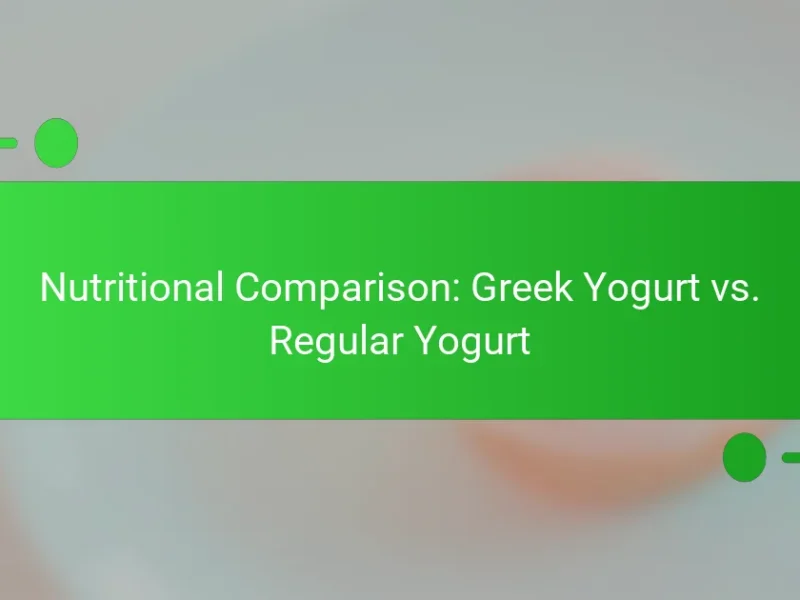Greek yogurt is a dairy product created through a fermentation process involving specific bacterial cultures, primarily Lactobacillus bulgaricus and Streptococcus thermophilus. These bacteria convert lactose, the sugar found in milk, into lactic acid, which thickens the yogurt and imparts a tangy flavor. The production process begins with heating milk to eliminate unwanted bacteria, followed by the addition of bacterial cultures and incubation at controlled temperatures. The fermentation not only enhances the yogurt’s texture and taste but also enriches its nutritional profile by increasing its probiotic content. The final product is a creamy, strained yogurt that is both versatile and healthful.

What is the fermentation process of Greek yogurt?
Greek yogurt is made through a fermentation process involving specific bacterial cultures. The primary bacteria used are Lactobacillus bulgaricus and Streptococcus thermophilus. These bacteria convert lactose, the sugar in milk, into lactic acid. The increase in lactic acid lowers the pH of the yogurt, causing it to thicken and develop a tangy flavor.
The process begins with heating milk to kill any unwanted bacteria. After cooling, the bacterial cultures are added to the milk. The mixture is then incubated at a controlled temperature, typically around 110°F (43°C), for several hours. During this time, the bacteria multiply and ferment the lactose.
Once the desired thickness and flavor are achieved, the yogurt is cooled to stop fermentation. The result is a creamy, tangy Greek yogurt, often strained to remove excess whey for a thicker texture. This fermentation process not only preserves the yogurt but also enhances its nutritional profile, making it rich in probiotics.
How does fermentation transform milk into Greek yogurt?
Fermentation transforms milk into Greek yogurt through the action of specific bacteria. These bacteria, primarily Lactobacillus bulgaricus and Streptococcus thermophilus, convert lactose in milk into lactic acid. The increase in lactic acid lowers the pH of the milk, causing it to thicken and develop a tangy flavor. This thickening occurs as proteins in the milk denature and coagulate. The fermentation process typically lasts several hours, during which the bacteria multiply and further enhance the yogurt’s texture and taste. Greek yogurt is then strained to remove excess whey, resulting in a thicker consistency compared to regular yogurt. The final product is rich in probiotics, which are beneficial for gut health.
What are the key microorganisms involved in the fermentation of Greek yogurt?
The key microorganisms involved in the fermentation of Greek yogurt are Lactobacillus bulgaricus and Streptococcus thermophilus. These bacteria work synergistically during the fermentation process. Lactobacillus bulgaricus contributes to the production of lactic acid, which thickens the yogurt. Streptococcus thermophilus helps in flavor development and enhances the fermentation rate. Together, they create the characteristic texture and tangy taste of Greek yogurt. The presence of these specific strains is vital for achieving the desired quality in Greek yogurt production.
How do temperature and time influence the fermentation process?
Temperature and time significantly influence the fermentation process. Higher temperatures accelerate fermentation by increasing the metabolic activity of bacteria. For Greek yogurt, an optimal temperature range is typically between 110°F to 115°F (43°C to 46°C). At this range, Lactobacillus bulgaricus and Streptococcus thermophilus thrive, producing lactic acid efficiently.
Time also plays a critical role. A typical fermentation duration for Greek yogurt is 6 to 12 hours. Shorter fermentation times yield a milder flavor and thinner texture. Conversely, longer fermentation can lead to a tangier taste and thicker consistency due to increased acid production.
Research indicates that fermentation at higher temperatures can reduce the overall fermentation time while maintaining quality. A study published in the Journal of Dairy Science found that increasing temperature by just 5°F could decrease fermentation time by 1 to 2 hours without compromising the yogurt’s texture or flavor.
What are the stages of the fermentation process for Greek yogurt?
The fermentation process for Greek yogurt involves several key stages. First, milk is heated to eliminate unwanted bacteria. This step ensures a controlled environment for fermentation. Next, the milk is cooled to the optimal temperature for the introduction of cultures. Specific bacterial strains, such as Lactobacillus bulgaricus and Streptococcus thermophilus, are added at this stage.
During the incubation period, the bacteria ferment lactose into lactic acid. This acidification thickens the milk and develops the yogurt’s tangy flavor. The fermentation typically lasts between 4 to 12 hours, depending on the desired taste and texture. After fermentation, the yogurt is cooled to halt the bacterial activity.
Finally, the yogurt is strained to achieve the thick consistency characteristic of Greek yogurt. This straining process removes excess whey, resulting in a creamier product. Each stage is crucial for developing the unique qualities of Greek yogurt.
What occurs during the initial stage of fermentation?
During the initial stage of fermentation, specific bacteria begin to convert lactose into lactic acid. This process starts when starter cultures are added to the milk. The bacteria thrive in the warm environment, leading to rapid growth. As lactic acid accumulates, the pH of the milk decreases. This acidic environment inhibits the growth of harmful bacteria. The texture of the milk begins to thicken as proteins denature. This stage is crucial for developing the flavor and consistency of Greek yogurt. It typically lasts several hours, depending on the temperature and bacterial strain used.
How does the second stage enhance the flavor and texture of Greek yogurt?
The second stage of fermentation enhances the flavor and texture of Greek yogurt by allowing beneficial bacteria to further metabolize lactose. This process produces lactic acid, which contributes to a tangy flavor profile. Additionally, the extended fermentation time thickens the yogurt, improving its creamy texture. The specific strains of bacteria used, such as Lactobacillus bulgaricus and Streptococcus thermophilus, play a crucial role in this transformation. Studies show that longer fermentation times lead to higher protein concentration and a richer mouthfeel. This stage is essential for developing the characteristic taste and consistency of authentic Greek yogurt.
Why is the fermentation process important for Greek yogurt?
The fermentation process is crucial for Greek yogurt because it transforms milk into a thick, tangy product. During fermentation, beneficial bacteria like Lactobacillus bulgaricus and Streptococcus thermophilus convert lactose into lactic acid. This acid thickens the milk and gives Greek yogurt its characteristic flavor. Fermentation also enhances the yogurt’s nutritional profile. It increases protein content and makes nutrients more bioavailable. Additionally, the process promotes probiotic development. Probiotics support gut health and boost the immune system. Studies indicate that fermented dairy products can improve digestion and overall health. Therefore, fermentation is essential for the texture, taste, nutrition, and health benefits of Greek yogurt.
What health benefits are associated with consuming fermented Greek yogurt?
Consuming fermented Greek yogurt offers several health benefits. It is rich in probiotics, which support gut health by enhancing the balance of beneficial bacteria. This can improve digestion and reduce symptoms of gastrointestinal disorders. Fermented Greek yogurt is also high in protein, promoting muscle health and aiding in weight management. Additionally, it contains essential nutrients like calcium and vitamin B12, which contribute to bone health and energy metabolism. Research indicates that regular consumption may lower the risk of chronic diseases, such as heart disease and diabetes, due to its beneficial effects on cholesterol levels and blood sugar regulation.
How does fermentation affect the nutritional profile of Greek yogurt?
Fermentation enhances the nutritional profile of Greek yogurt by increasing its probiotic content and digestibility. During fermentation, lactose is converted into lactic acid, which makes yogurt easier to digest for lactose-intolerant individuals. This process also boosts the presence of beneficial bacteria, such as Lactobacillus and Bifidobacterium, promoting gut health. Furthermore, fermentation can increase the bioavailability of certain nutrients, making them easier for the body to absorb. Studies show that Greek yogurt often contains higher levels of protein compared to regular yogurt, contributing to satiety and muscle health. Overall, fermentation significantly enriches Greek yogurt’s nutritional value.
How can the fermentation process of Greek yogurt be optimized?
To optimize the fermentation process of Greek yogurt, controlling temperature and time is essential. Maintaining a consistent temperature between 110°F to 115°F promotes optimal bacterial activity. Fermentation should last 6 to 12 hours to achieve the desired thickness and tanginess. Using high-quality starter cultures ensures a robust fermentation process. Additionally, adjusting the ratio of milk to starter culture can influence the texture and flavor. Regularly monitoring pH levels helps determine fermentation progress, aiming for a pH of around 4.6. Finally, using specific strains of Lactobacillus bulgaricus and Streptococcus thermophilus enhances the fermentation efficiency and flavor profile.
What techniques can be used to control fermentation conditions?
Temperature control is a primary technique used to manage fermentation conditions. Maintaining a consistent temperature optimizes the activity of specific bacteria in yogurt production. The ideal fermentation temperature for Greek yogurt typically ranges from 110°F to 115°F (43°C to 46°C). Monitoring and adjusting the temperature can significantly impact the texture and flavor of the yogurt.
pH control is another crucial technique. The pH level influences the fermentation rate and the final taste of the yogurt. Regularly measuring pH during fermentation allows for adjustments to maintain optimal acidity.
Oxygen control is also important. Anaerobic conditions are essential for the growth of certain bacteria while inhibiting unwanted microbial activity. Using sealed containers or anaerobic chambers can help achieve this environment.
Time management plays a significant role as well. The duration of fermentation affects the yogurt’s thickness and tanginess. Experimenting with fermentation times allows producers to tailor the yogurt to desired specifications.
Finally, ingredient control, such as the quality and type of milk and starter cultures, directly influences fermentation. High-quality ingredients lead to better fermentation outcomes. These techniques collectively ensure successful fermentation in Greek yogurt production.
How can home yogurt makers achieve consistent fermentation results?
Home yogurt makers can achieve consistent fermentation results by maintaining stable temperature and using quality starter cultures. The ideal fermentation temperature for yogurt is between 110°F to 115°F. This warmth encourages the growth of beneficial bacteria. A yogurt maker provides a controlled environment to maintain this temperature.
Using fresh, high-quality starter cultures ensures that the right bacteria are present. These cultures should contain live active cultures for optimal fermentation. Additionally, the fermentation time should be monitored. Typically, yogurt ferments for 6 to 12 hours, depending on desired thickness and tartness.
Regularly checking the consistency and flavor during fermentation helps in adjusting future batches. Following these practices can lead to reliable and repeatable yogurt-making outcomes.
What common challenges arise during the fermentation of Greek yogurt?
Common challenges during the fermentation of Greek yogurt include temperature control, contamination, and texture issues. Temperature control is crucial, as fermentation occurs optimally between 110°F and 115°F. If the temperature is too low, fermentation slows down. Conversely, if it is too high, it can kill the beneficial bacteria. Contamination can occur from improper sanitation of equipment. This can introduce harmful bacteria, affecting the yogurt’s safety and flavor. Texture issues may arise if the yogurt separates or becomes too thin. This can result from insufficient fermentation time or inadequate straining of whey. Each of these challenges can impact the final quality of the Greek yogurt produced.
What are the signs of improper fermentation in Greek yogurt?
Signs of improper fermentation in Greek yogurt include an off or sour smell. A watery consistency can also indicate fermentation issues. Additionally, the presence of mold or unusual colors signifies spoilage. If the yogurt tastes overly bitter or has a grainy texture, these are signs of improper fermentation. These characteristics suggest that the fermentation process has not occurred correctly. Proper fermentation typically results in a creamy texture and a tangy flavor. Maintaining the right temperature and time is crucial for successful fermentation.
How can one troubleshoot fermentation issues in homemade Greek yogurt?
To troubleshoot fermentation issues in homemade Greek yogurt, check the temperature first. The ideal fermentation temperature is between 110°F and 115°F. If the temperature is too low, fermentation slows down. If too high, it can kill the cultures. Next, examine the starter culture. Ensure it contains live active cultures. Using expired or inactive cultures can lead to failure.
Inspect the milk used for yogurt. Whole milk yields creamier yogurt. Low-fat or skim milk may not ferment properly. Additionally, ensure the fermentation time is adequate. Typically, it should last 6 to 12 hours. Under-fermentation can result in a runny texture. Over-fermentation may lead to a sour taste.
Lastly, maintain a clean environment. Contaminants can disrupt the fermentation process. Use sanitized equipment to prevent unwanted bacteria. Following these steps can help achieve successful fermentation in homemade Greek yogurt.
What tips can enhance the fermentation process of Greek yogurt?
To enhance the fermentation process of Greek yogurt, maintain optimal temperature. The ideal range is between 110°F to 115°F. This temperature encourages the growth of beneficial bacteria. Use a yogurt starter with live cultures for effective fermentation. Ensure the milk is heated and cooled properly before adding the starter. Stir gently to distribute the cultures evenly. Cover the yogurt to retain warmth and humidity during fermentation. Allow sufficient time for fermentation, typically 6 to 12 hours, depending on desired thickness. After fermentation, refrigerate the yogurt to halt the process and improve flavor.
The main entity of this article is Greek yogurt, specifically focusing on its fermentation process. The article provides a detailed overview of how Greek yogurt is produced through the fermentation of milk using specific bacterial cultures, primarily Lactobacillus bulgaricus and Streptococcus thermophilus. Key aspects include the stages of fermentation, the influence of temperature and time, the health benefits associated with consuming Greek yogurt, and techniques for optimizing the fermentation process. Additionally, it addresses common challenges and troubleshooting tips for achieving successful fermentation in homemade Greek yogurt.


